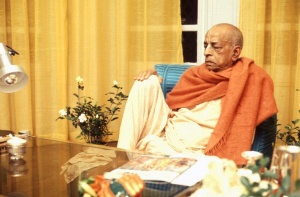CC Madhya 20.175 (1975): Difference between revisions
(Vanibot #0027: CCMirror - Mirror CC's 1996 edition to form a basis for 1975) |
(Vanibot #0020: VersionCompareLinker - added a link to the Version Compare feature) |
||
| Line 2: | Line 2: | ||
<div style="float:left">'''[[Sri Caitanya-caritamrta (1975)|Śrī Caitanya-caritāmṛta (1975)]] - [[CC Madhya (1975)|Madhya-līlā]] - [[CC Madhya 20 (1975)|Chapter 20: Lord Śrī Caitanya Mahāprabhu Instructs Sanātana Gosvāmī in the Science of the Absolute Truth]]'''</div> | <div style="float:left">'''[[Sri Caitanya-caritamrta (1975)|Śrī Caitanya-caritāmṛta (1975)]] - [[CC Madhya (1975)|Madhya-līlā]] - [[CC Madhya 20 (1975)|Chapter 20: Lord Śrī Caitanya Mahāprabhu Instructs Sanātana Gosvāmī in the Science of the Absolute Truth]]'''</div> | ||
<div style="float:right">[[File:Go-previous.png|link=CC Madhya 20.174 (1975)|Madhya-līlā 20.174]] '''[[CC Madhya 20.174 (1975)|Madhya-līlā 20.174]] - [[CC Madhya 20.176 (1975)|Madhya-līlā 20.176]]''' [[File:Go-next.png|link=CC Madhya 20.176 (1975)|Madhya-līlā 20.176]]</div> | <div style="float:right">[[File:Go-previous.png|link=CC Madhya 20.174 (1975)|Madhya-līlā 20.174]] '''[[CC Madhya 20.174 (1975)|Madhya-līlā 20.174]] - [[CC Madhya 20.176 (1975)|Madhya-līlā 20.176]]''' [[File:Go-next.png|link=CC Madhya 20.176 (1975)|Madhya-līlā 20.176]]</div> | ||
{{CompareVersions|CC|Madhya 20.175|CC 1975|CC 1996}} | |||
{{RandomImage}} | {{RandomImage}} | ||
==== TEXT 175 ==== | ==== TEXT 175 ==== | ||
| Line 18: | Line 17: | ||
<div class="synonyms"> | <div class="synonyms"> | ||
vaibhava-prakāśa—the feature of vaibhava-prakāśa; yaiche—just as; devakī-tanuja—the son of Devakī; dvi-bhuja—two-handed; svarūpa—form; kabhu—sometimes; kabhu—sometimes; haya—is; | vaibhava-prakāśa—the feature of vaibhava-prakāśa; yaiche—just as; devakī-tanuja—the son of Devakī; dvi-bhuja—two-handed; svarūpa—form; kabhu—sometimes; kabhu—sometimes; haya—is; catuḥ-bhuja—four-handed. | ||
</div> | </div> | ||
| Line 25: | Line 24: | ||
<div class="translation"> | <div class="translation"> | ||
"An example of vaibhava-prakāśa is the son of Devakī. He sometimes has two hands and sometimes four hands. | |||
</div> | </div> | ||
| Line 32: | Line 31: | ||
<div class="purport"> | <div class="purport"> | ||
When Lord Kṛṣṇa took His birth, He appeared outside the womb as four-handed Viṣṇu. Then Devakī and Vasudeva offered their prayers to Him and asked Him to assume His two-handed form. The Lord immediately assumed His two | When Lord Kṛṣṇa took His birth, He appeared outside the womb as four-handed Viṣṇu. Then Devakī and Vasudeva offered their prayers to Him and asked Him to assume His two-handed form. The Lord immediately assumed His two handed form and ordered that He be transferred to Gokula on the other side of the River Yamunā. | ||
</div> | </div> | ||
Latest revision as of 12:48, 27 January 2020
Śrī Caitanya-caritāmṛta (1975) - Madhya-līlā - Chapter 20: Lord Śrī Caitanya Mahāprabhu Instructs Sanātana Gosvāmī in the Science of the Absolute Truth

His Divine Grace
A.C. Bhaktivedanta Swami Prabhupada
A.C. Bhaktivedanta Swami Prabhupada
TEXT 175
- vaibhava-prakāśa yaiche devakī-tanuja
- dvibhuja-svarūpa kabhu, kabhu haya caturbhuja
SYNONYMS
vaibhava-prakāśa—the feature of vaibhava-prakāśa; yaiche—just as; devakī-tanuja—the son of Devakī; dvi-bhuja—two-handed; svarūpa—form; kabhu—sometimes; kabhu—sometimes; haya—is; catuḥ-bhuja—four-handed.
TRANSLATION
"An example of vaibhava-prakāśa is the son of Devakī. He sometimes has two hands and sometimes four hands.
PURPORT
When Lord Kṛṣṇa took His birth, He appeared outside the womb as four-handed Viṣṇu. Then Devakī and Vasudeva offered their prayers to Him and asked Him to assume His two-handed form. The Lord immediately assumed His two handed form and ordered that He be transferred to Gokula on the other side of the River Yamunā.